One of the most common defects at old Minneapolis and Saint Paul houses is a missing cleanout plug in the floor drain. When we find this during a Truth In Sale of Housing Evaluation in Minneapolis, it’s actually a required repair item. A missing cleanout plug can allow hazardous sewer gas into the home and often indicates a clogged floor drain. To learn why and how, read on.
Every plumbing fixture has a trap. A plumbing trap prevents foul-smelling sewer gas from entering a home. The image below shows a P-trap, which can be found at sinks, showers, and bathtubs.
The left side of the trap connects to the plumbing fixture, and the right side connects to the sewer. The ‘sewer’ side will have sewer gases present, but the water at the bottom of the trap prevents sewer gases from entering the building.
Floor drains are no exception. The photo below shows a floor drain viewed from the side.
The shaded portion shows the trap where water will always sit, which prevents sewer gas from entering the building. When you look at an installed floor drain, all that you typically see is the grill on top; the rest of the drain is always buried in the basement floor.
What if the drain is clogged?
Floor drains clogs happen in two places; one is the trap itself, and the other is a clog in the line downstream from the drain. To know the difference, try removing the cleanout plug; it’s that thing I circled in the photo below.
This will allow water to drain past the trap, through the area highlighted below.
If you remove this plug and water drains properly, you have a problem with the trap, and your best bet is to use a drain auger to clean out the trap. As long as someone didn’t pour concrete or tile grout down the drain, it shouldn’t be a big deal to fix this. If you remove the cleanout plug and water still doesn’t drain, you have a problem with the drain line downstream from the trap. Try using a drain auger to clean out the line by pushing it through the cleanout hole.
When this plug is removed, however, sewer gas will enter the building. After you’ve cleaned the drain, be sure to put the cleanout plug back into place. You don’t want stinky sewer gas coming into your home.
What if the cleanout plug is missing?
If you have an existing floor drain with a missing cleanout plug, it usually means one of two things:
- The drain was clogged, someone removed the cleanout plug to clean the drain, and they forgot to replace the plug.
- The bottom of the trap is clogged, and someone removed the cleanout plug to allow water to drain directly into the sewer, instead of going through the trap.
To know the difference, take a look at the water level. If the water is right at the cleanout hole, you have a clogged trap that needs service. If the water level is a couple of inches below the cleanout hole, you should be fine. All you need to do is replace the cleanout plug.
On some older floor drains, the threads that used to accept a cleanout plug are damaged or badly rusted, so it’s impossible to screw in a new cleanout plug. The right way to fix this is to install a rubber plug. One type of plug is a piece of rubber sandwiched between two pieces of metal that expand the rubber when tightened together. The two photos below show a rubber plug before it’s tightened and after it’s tightened.
Another type of rubber plug can be found at Real-Tite Plugs – a company located in Golden Valley.
When the cleanout plug is missing it needs to be replaced, and the floor drain may need to be cleaned out or replaced. If the drain cannot be cleaned, the entire floor drain needs to be replaced.

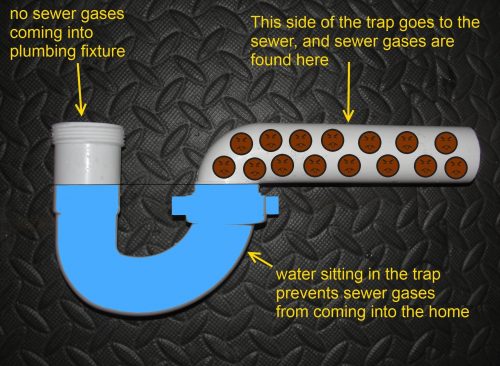
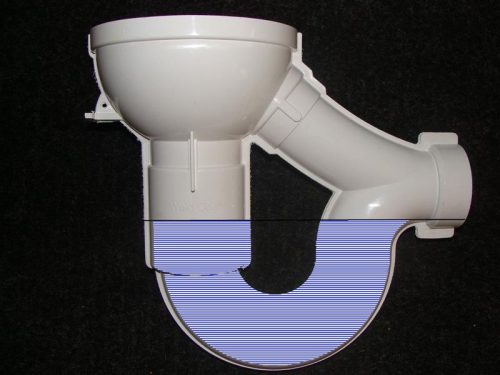
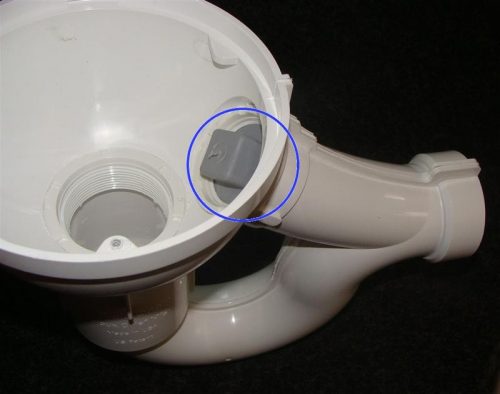
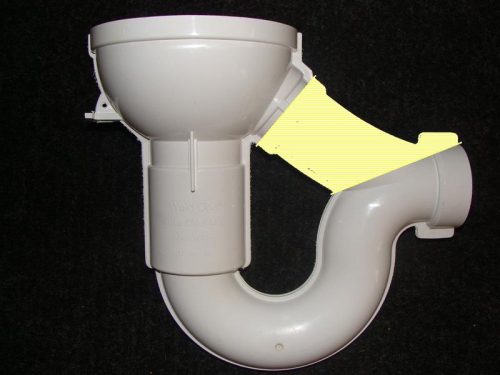

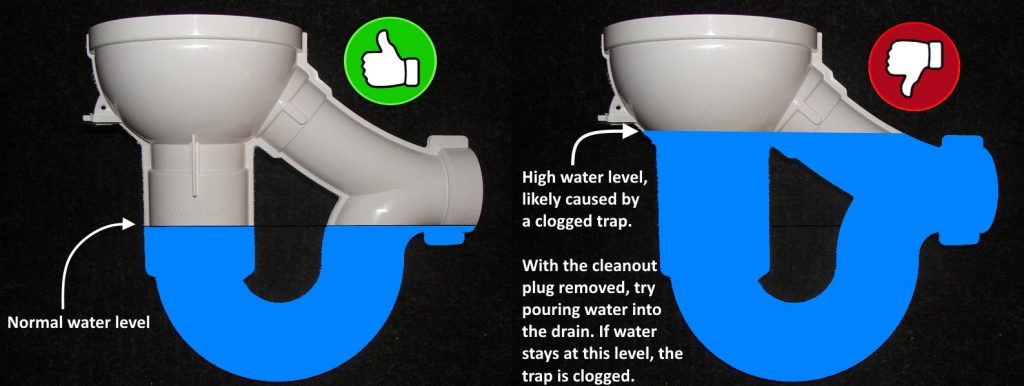
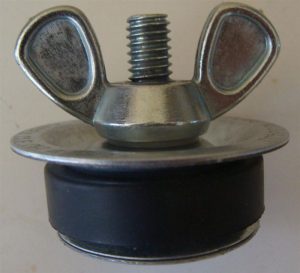
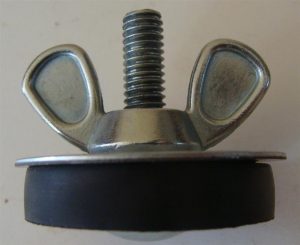
home inspection sussex county
July 31, 2009, 11:12 am
very informational!
Rick Absi
August 17, 2009, 6:46 am
Great article. I’ve been struggling with a sewer odor in our house for a long time, and I think I’ve identified the floor drain as the source. The floor drain is used for condensate from the evaporator coil on the air conditioner. It’s located in the garage. The house is 11 years old, built slab-on-grade. We’re connected to city water/sewer.
I’ve tried to look for the cleanout plug in the drain, but I can’t find it. Is it possible that I have a floor drain without a cleanout? Or am I just missing something? I greatly appreciate your input. The smell is really bad and very annoying! Thank you.
Reuben Saltzman
August 17, 2009, 5:03 pm
Rick – some floor drains don’t have cleanout plugs. Maybe the trap has dried out? If the water dries out, you’ll get sewer gas. Send me a photo or two, and I’ll give you an opinion and post the photos.
Chris Anstey
January 4, 2010, 10:17 pm
I have just recently removed the drain cover from the floor drain in the basement, the drain is blocked but water does seap out very slowly . I noticed this plug on the side of the drain and now understand what it is for . is there any special technique for removing the plug from the drain wall. Drain is cast approximately 60 years of age . Would draino in hoy water help with clearing the floor drain. Any assistace would be appreciated.
Reuben Saltzman
January 5, 2010, 6:25 am
Most old plugs are threaded in place, and can be removed with a pipe wrench. I don’t think any type of liquid drain cleaner would help – I’ve never had any luck with liquid drain cleaners. They’re supposed to work on hair, and I’ve found them to do a marginal job of that. I’d use a ‘snake’, which is slang term for a mechanical drain cleaning tool.
A Missing Jumper Wire At The Water Meter | Reuben's Home Inspection Blog
January 29, 2010, 6:43 am
[…] Floor Drains […]
Mark Schreiber
March 4, 2010, 2:17 pm
As a response to Rick’s problem and anyone else that is experiencing sewer gases and odors from their floor drains; this is generally because the water traps in the pipes have dried out. This allows the gases to enter into your home or even into your place of work. Over time, the water trap will evaporate if not regularly used or flushed. I have found and researched into a product called TheSureSeal which you can easily place within your floor drain, whether in your bathroom, shower, or even in the water heater drain. TheSureSeal is a device that you can place in your drain in just a matter of minutes. It is very effective and easy to use.
Reuben Saltzman
March 4, 2010, 5:55 pm
Mark – I debated posting your comment because it sounds like you’re trying to sell your goods on my blog. Come now, you didn’t really find and research this product; you’re selling it, right?
I posted your comment anyways because I’ve never seen this product before. What advantages would this product have over pouring some anti-freeze in to the drain, probably at a fraction of the cost?
Mark Schreiber
March 11, 2010, 3:25 pm
Okay well first of all “research the product”. It’s something everyone does. If you go into something blind and don’t research it then you’re sometimes in for a rude awakening.
And to answer your question, it’s not that it kills bacteria which is I suppose what anti-freeze would do, but anti-freeze doesn’t solve the problem of failed water traps. This device prevents the odors that the sewer would otherwise bring up with a failed trap scenario.
Secondly, putting solutions into your pipes can only be worse for the environment. This is chemical free.
Reuben Saltzman
March 11, 2010, 4:05 pm
Very good, thanks.
Toilet Repair - Fixing An Improper Air Gap On A Ballcock | Reuben's Home Inspection Blog
March 19, 2010, 11:40 am
[…] Floor Drains […]
David
April 18, 2010, 5:35 am
I wonder if you can tell me how would I know for sure that a drain in my basement goes to the sewer or if it just goes to a dry bed? I started making a shower around it and had to stop until I figure that one out. I opened the drain cover and there was a 4 inch tube that looked like a pencil that was coming out of the side that felt like it was soft copper as I could bend it. The house is 30 years old in Canada the drain goes down about a foot and turns. There was also a rough in for a toilet and sinc….any help would be appreciated as this project has been on stall for the past year now.
Reuben Saltzman
April 21, 2010, 5:09 am
Hi David,
If you have a main sewer cleanout hole right before your main drain leaves the house, try removing the cover, then pour a bunch of water down the floor drain. If it goes out to the sewer, you’ll be able to see the water from the cleanout hole.
The soft copper tube that you’re referring to is probably a trap primer – it’s a device that will periodically dump a little bit of water in to the floor drain to prevent it from drying out.
Carbon Monoxide Alarm Requirements For Minnesota | Reuben's Home Inspection Blog
April 26, 2010, 7:44 pm
[…] Floor Drains […]
David
August 25, 2010, 6:31 am
You are a brilliant man as I have been trying to figure this out for a couple of years and nobody had a clue how to figure out my problem but you did…..THANK YOU….MY DRAIN GOES TO THE SEWER.!!!!
Jeff
October 1, 2010, 11:14 am
My basement floor drain (which has a cleanout) needs water poured in it every other day when the heater or a/c isn’t running to stop sewer gases. My house was built in 1961. Do these traps ever need replacing because of rusting through or cracking? If so, how big of a job is it? The drain is in a concrete floor.
Reuben Saltzman
October 1, 2010, 2:08 pm
Hi Jeff,
Yes, cracks can certainly develop. It sounds like that’s what happened to you. It’s not a quick and easy project to replace the floor drain – you’ll need to break up the concrete in the floor and dig out the dirt under and around the floor drain in order to get it out. After you replace it, you’ll need to pour new concrete.
Jeff
October 1, 2010, 2:16 pm
Thanks Reuben
Deanna Synowiec
October 15, 2010, 7:10 pm
Sounds like you may be just the person to help me. We have lived in our home for 14 years. We have trees in our area and have had to regularly snake our drains. It works until the next big growing season. So, this, we are accustomed to. Three weeks ago we had a bad sewage back up in the basement and figured, time to snake again. The plumber came out, snaked as usual finding the usual root balls etc, we ran tons of water in the house, flushed toilets repeatedly, spun water out of the washer and poured water down the drain all at the same time to make sure it was all clear. We have had no back ups since, and the surrounding area has been thoroughly cleaned, but we do have an awful sewage smell remaining. This smell can permeate the whole house and in order to keep it at bay we have to close the basement door. Knowing that the trap can go dry, we have repeatedly poured buckets of water down the the drain (it’s the one by the furnace that leads out to the main) We have even used a bleach and water solution in the drain. All of this only works for about 24-48 hours. We are at a loss as we have not had this problem post snaking in the last 14 years (and we have done plenty of snaking-sometimes twice per year). What advice do you have for this? I pray it isn’t the dreaded break up the basement floor and spend your life savings situation. Thank you for your reply in advance-now, be my hero!
Reuben Saltzman
October 16, 2010, 5:14 am
Hi Donna,
When your plumber snakes out your main drain line, I’m sure he or she is removing the cleanout plug from the main waste line, which is probably a three or four inch plug.
I don’t think your issue is a dry trap – if you look in your floor drain and you can see water, you don’t have a dry trap. Your issue is probably a missing cleanout plug in the main building drain. I don’t know where you’re writing from, but on most older homes here in Minneapolis and Saint Paul, the main cleanout plug is typically located in the floor very close to the water meter.
Find your main cleanout and make sure the plug is in place. Good luck.
Deanna Synowiec
October 16, 2010, 3:03 pm
The plug is in place and nicely fitted. Any other ideas.
Deanna Synowiec
October 16, 2010, 3:04 pm
Oops! Forgot to include that we are in Michigan just outside of Detroit. A Cape Sod style bungalow that was built in the 20’s or 30’s.
Reuben Saltzman
October 17, 2010, 1:14 pm
So you have a cleanout plug in the main building drain, a cleanout plug in the floor drain, water in the trap of the floor drain… yet you’re still getting sewer gases in the basement.
I’m out of ideas. I’d say it’s time to call a plumber. Let me know what you find out.
Andy
November 13, 2010, 7:50 pm
Thank you, very helpful! Needed to see a diagram of a floor drain, our drain is clogged but I could remove the clean out plug (which I did, and put back) if the floor flooded. The question is do I attempt to clean out the drain knowing this could result in an expensive replacement or just call it quits for now?
Again, thank you.
Reuben Saltzman
November 13, 2010, 9:03 pm
Andy – go ahead and try to clean the drain out. You probably won’t make things any worse.
Heating Service
December 8, 2010, 8:48 am
Thank you for this well written advice, very helpful.
roseville pipe clean out
March 15, 2011, 7:10 am
A very informative piece.
I think our drains look better than the ones in the picture.
Any problem we encounter, if my husband cannot fix it, time to call in reinforcements, a plumber.
george.elaine12 @ floor drains
July 7, 2011, 6:31 am
This is a great and informative article. Quite helpful for anyone who is new to fixing floor drains, etc.
Larry Czarnecki
July 11, 2011, 8:40 pm
Reuben need your advise please. Can the basement floor drain be snaked? My house is 40 yrs. old. I’ve snaked the clean-out on the side. The drain has water in it but drains VERY SLOW. I live in Apple Valley MN. Am I dealing with a P-trap? What’s you take on this?
Reuben Saltzman
July 12, 2011, 3:54 am
Hi Larry,
Yes, it sounds like you’re dealing with a clogged P-trap. You can certainly shove something in the trap to try cleaning it out, but there is no guarantee that it will work. I personally had to replace a floor drain at my sister’s house because the P-trap was filled with concrete.
Smoke Detector Safety | Structure Tech Home Inspections
July 13, 2011, 5:31 am
[…] Floor Drains […]
Lynn Syverson
July 31, 2011, 1:16 am
Reuben,
I’m hoping you can help me. This evening I ran a load of laundry in my basement washer which drains into the laundry tub only to come down to transfer to the dryer instead finding clean water covering the basement. Took me a while to figure it out as the only place there wasn’t water was by the laundry tub and washer/dryer! I believe it is the floor drain (glad it was clean water) and think it may be because hubby decided to give the laundry tub and it’s drain a thorough cleaning. Must have pushed enough grunge through to create a blockage. Knowing all this, do I follow your snaking method above? This will be my first time so your guidance is much appreciated. I’m a fixer, he’s a “call a repairman.”
Lynn Syverson
July 31, 2011, 1:40 am
Just looked in the drain and it’s very deep with no visible clean out plug?
Reuben Saltzman
August 1, 2011, 3:18 pm
Hi Lynn,
Yes, I think that snaking out the drain would be worthwhile; just make sure you have a long enough snake. As for the deep drain with no cleanout plug – some older floor drains just don’t have cleanouts. The drain at your laundry sink should have a cleanout hole, and that pipe probably connects to the same line at the floor drain.
Sinks
August 11, 2011, 5:39 am
This is really quite a nice article with regards to the drains, I do appreciate the author for providing such a wonderful piece of information…
Pat
September 27, 2011, 9:21 am
Something somewhat related, if the trap dries out and you have a whole house fan running and forget to open the windows, you will pull gasses out of the drain …. stunk the entire house up before I figured out what happened.
Clint Kingsbury
November 2, 2011, 12:38 pm
hello, i have a very old house and there seems to be many strange drains in my basement. one has a wingnut type rubber seal, the other side of the basement has a removable over like a lid. these seem not to be the issues…
the issue i have is in one of my separate rooms in the basement there is a 1ft x1.5ft resovoir that has a removable metal lid on it. just in front of it looks like a drain clean out (not sure) and i can not get it off….
but when i left of the metal lid, there is some standing water and it smells. what to do? can you email me and i will take pics and show…
Reuben Saltzman
November 2, 2011, 2:58 pm
Clint – my email address is reuben@structuretech1.com
Clay
November 3, 2011, 8:00 am
We have a partially clogged cast iron 5 inch trap that carries runnoff from the roof of a 4 unti coop. The plumber is suggesting we change the trap. We suspect the trap only needs cleaning out and doesn’t need replacing. I can’t tell the age of the pipe but we know the building was gutted/renovated in the early/mid 80s. Is changing the trap really necessary for a pipe that isn’t that old? They seems to be not even bothering with an attempted cleanout (more $$ for the plumber part of the job). How does one evaluate whether to clean out the trap vs replace it?
Reuben Saltzman
November 3, 2011, 1:38 pm
Clay – I would certainly try cleaning out the trap before replacing it. I don’t know why you would need to change the trap out. You should ask your plumber why they’re recommending that.
Aida
November 6, 2011, 10:56 am
Hi Reuben,
I am in the process of buying home in Bloomington, Mn and one of the homes that I am really interested in has no clean out plug in floor drain. Reading some of your previous posts, sounds like replacing a clean out plug is a coslty fix. Can you run an estimate for me? Thank you in advance and God bless you for sharing your skills and knowledge!!
Reuben Saltzman
November 7, 2011, 4:46 am
Hi Aida,
Most of the time, replacing a missing cleanout plug is a quick and easy repair. The replacement cleanout plug that I showed sells for about $5, doesn’t take any tools to install, and takes about one minute to pop in and secure. Good luck.
– Reuben
BCG
November 8, 2011, 6:37 pm
When the water in the trap portion of your drain evaporates, this removes the natural water seal and opens your home to disease carrying bugs and sewage gas smell. H2GOFlo and the the Interceptor-Plus replenishes this water periodically, creating the required barrier, that blocks off the back flow from the sewer system from having direct access into your home. h2goflo.com
Becky
November 11, 2011, 12:31 am
Hi Reuben,
I have a floor drain in the basement laundry room. It is not draining. I know this because when replacing the hot water tank, the guys tried to drain it into the floor, and it wouldn’t drain. They told me it is serious and I should snake it out.
I can’t snake it, because in my 44 yr. old house, the drain is cemented in the floor. What to do?
Reuben Saltzman
November 11, 2011, 4:33 am
Hi Becky,
Here in Minnesota, floor drains are always cemented in to the floor, regardless of age. The cleanout plug is there so the drain can be snaked out. I suggest you hire a drain cleaning company to snake out the floor drain. If the drain can’t be snaked out, your options would be to live with a clogged floor drain or have the drain replaced.
– Reuben
Stephanie
November 15, 2011, 4:55 pm
Hi. I recently purchased a home. The floor drain has clean water sitting in it. Both drain holes are open without plugs. The p-trap part has visible water standing in it and all new water exits to the side which I believe is the bypass.
Reuben Saltzman
November 16, 2011, 9:00 pm
Stephanie – you should install a cleanout plug at the cleanout hole.
Tom
November 27, 2011, 10:49 am
Reuben you are the best! Just wanted to say thanks for the pictures and advice on this web page. If it wasn’t for finding this information, I would have dug up the floor drain with my bare hands out of frustration. Finding the cleanout plug under the dryer and groping in the standing water for the cleanout hole, I was able to snake it out to the main and now…no problems! Thanks again from SLP!
Reuben Saltzman
December 12, 2011, 2:43 pm
@Tom – I’m glad I was able to help someone local 🙂
Why Do I Need A Vacuum Breaker? | Structure Tech Home Inspections
December 1, 2011, 6:34 am
[…] Floor Drains […]
Stephanie
December 12, 2011, 10:05 am
Should the water be clear in a floor drain? I have a home on a slab that has a floor drain near the water heater. We have backed up through there about 9 years ago and them maybe about 6 years ago. We have had the line scoped with a camera and all they have seen is an area where the pipe is bellied (?) From time to time we see waste in there and were told it was a product of waste being caught up in the line and coming up after backing up in the past. We shop vac-d it out (PU!) and it was clear for about a month then we saw a bit more waste so I cleaned it out again. It had been about a week now. It looks ok. The water was clear when I filled it up but now has a rusty appearance. Does stuff ever gunk up in there under normal circumstances? Thanks!
Reuben Saltzman
December 12, 2011, 2:46 pm
@Stephanie – Yes, the water should typically be clear, however, if it’s a very old drain the water will always look dirty. If the water gets dirty fairly quickly, it’s probably a good sign that you have a problem with the drain(s) in your house. Try filling up your bath tub(s) with water, pull the plugs, then go downstairs and run the water full blast at your laundry sink while the tubs are draining. If the floor drain backs up while this is happening, there’s your answer.
Stephanie
December 13, 2011, 8:27 pm
Well, we are on a slab and don’t have a laundry tub. I had a plumber out though and he opened up the clean out in the front of the house and had me fill the tub and then we watched the clean out while it drained and the water was flowing out just the way it should. There is also no movement in the water level in the floor drain when toilets are flushed and all that. Also, the pipes are old, about 30-35 years old. It is definitely a disgusting looking rusty pipe, cast iron? I guess we will just watch it for now. The water almost has a rusty color to it.
Reuben Saltzman
December 14, 2011, 8:42 pm
It sounds like you might just have to settle for rusty looking water in your floor drain. Probably nothing to worry about if nothing is backing.
Reuben Saltzman
December 14, 2011, 8:43 pm
It sounds like you might just have to settle for rusty looking water in your floor drain. Probably nothing to worry about if nothing is backing up.
Stephanie
December 21, 2011, 7:38 am
Well, by now there is stuff filling up in there,. The water went from rusty to dark blackish and there was something that was identifiably eaten about two days earlier that was visible in there. I fear we have a massive issue on our hands, the stuff is seeping in somewhere! I will follow up once it is resolved just in case you are curious of the outcome. Thanks for all of your insight!
Reuben Saltzman
December 23, 2011, 7:00 am
@Stephanie- thanks for the follow up post. I’ll be interested to hear how this turns out.
Teri
December 22, 2011, 11:02 pm
Hi Reuben. I have an oder in my basement, but not sure what it is. It’s either coming from the floor drain or the neighboring bathroom. I am the only one who smells it, husband does not and plummers say it’s not bad. They tell me to poor water down the drain. I do this every couple days and it helps but it comes back. It doesn’t necessarily smell like sewer but rather some sort of metalic smell or gas. I can’t stand it though, it’s so pervasive I smell it all our clothes whenever we leave our house. This problem is causing marital problems cause husband thinks it’s pyscological.
in to my home through the basement floor drain, I believe I’ve had a couple plummets who tell me
Teri
December 22, 2011, 11:05 pm
Sorry Rueben, hit send too early. Is sewer smell very obvious or could it smell Ike something metalic? House was built in 1958. Thanks for any input. In the meantime I guess we’ll check the plug. Thanks.
Spence
December 28, 2011, 11:55 am
I have a floor drain in my basement that is used as a shower drain. It is draining very slowly and I have opened the cleanout and snaked it and also checked the vent and made sure it was clear. The drain has a ball in it that I think is for preventing backups but it does not let me snake out the trap if there is one. The water drains well through the cleanout but not through the drain itself. Can I remove the ball or is this my only stop for sewer gas in this type of drain.
Reuben Saltzman
January 1, 2012, 7:19 am
Spence – yes, you can remove the ball. That ball is there to help prevent water from backing up out of the floor drain, not to prevent sewer gases from coming in.
Mark
January 21, 2012, 5:47 pm
All of the five Drake cast-iron floor drains in basement of my recently purchased 57 year-old house are the type with the trap clean-out plug adjacent to the grate at the top of the trap rather then inside of the grate.I am having performance problems with at least three out of five of them, including the most critical one that my AC condensate, HE furnace condensate and humidifier all drain into.I have had to disable the humidifier for now until I get this one working.
1.) The threaded trap plugs all appear to be ferrous metal rather then brass. They have what appears to be 3/4″ recessed square sockets such that there is no way to grab with a pipe-wrench (think big hex or torx socket except square shape). These surface-flush square sockets are filled with concrete which would need to be chiseled out before any tool can be applied in attempt to break them free. If I am successful in cleaning these concrete from sockets, the next challenge is just how best to break them free. I am thinking PB Blaster and then 3/4″ drive breaker bar with nothing on it but perhaps 3/4 drive extension. Is there a better tool or drive accessory for this application? Would you think applying heat with MAP gas torch would be a good idea before applying maximum brute-force. Based on the level of rust of the whole assemble these plugs appear to possibly be badly frozen. That has me thinking Plan B already, which would be to abandon attempt to open the rust-frozen concrete-filled trap plugs and instead try to go at clean-out directly through the drain inlet.
2.) The only grate that I can readily remove at the moment (more on that below) was over one of the drains I am having performance issues with. I was able to vacuum out a good bit if sand and concrete chips. Prior to this I had a plumber here for something unrelated. He tried to snake it through the trap but failed. About this plumber, I got a home warranty as part of the house purchase deal 1.5 years ago and they are the ones that sent him. I am suspecting he use to make a living doing construction and now due to construction market collapse is trying to make it in service. My point is that just because this plumber failed does not mean that something cannot be done. But I am wondering if there is something other then a snake you can recommend for breaking through the debris in the trap and the first few feet of drain line. At that point if I cannot work a snake through the trap adequately I am considering a jetter attachment for my 2800psi, 2.7 gpm pressure washer (example, ClogHog but feel free to delete the brand name as this is not an attempt to endorse them). The appeal there is that the hose diameter is much smaller and more flexible then head of a snake. Have you had any experience with jetters? Care to comment?
3.) Finally, can you suggest a method for removing the grates without destroying them since these are no longer in production . They are held in place with what appear to be an impossibly frozen pan-head screw. I tried PB Blaster, but this flat-head screw is standard slot so I am doubtful I can apply enough torque to break it lose before stripping the slot. Should I just drill it out? Or should I not waste my time trying to save the grate and just break it off and then try to find a suitable aftermarket replacement. They have the name BLAKE stamped into them so if you know where to obtain replacement grates that would be a decent fit that would be appreciated too.
A final note, I am puzzled as to why drains with traps were even used on this house. I am pretty sure they do not drain into the septic system but rather are piped directly out to the creek along rear of the property. There is a pipe that drains out there. I know it could be just storm run-off but I am thinking it is grey-water too including run-off from these floor drains. Each property here has a line like this dumping into the creek so apparently that was legal and accepted practice in 1950 and early 60s. Whatever the case, most of the 5 traps are bone dry most of the time and I have no issue with sewer gas coming up through them.
Thank you,
Reuben Saltzman
January 22, 2012, 8:06 am
Mark – you have quite the interesting setup.
1 – Try a huge screw extractor.
2 – I’ve never tried a jetter. It sounds like a good plan, but I don’t know enough about this process to say yay or nay.
3 – Again, try a screw extractor. You just drill a tiny hole in the screw, then thread the screw extractor in to it.
As for the traps – assuming your drains go out to a creek, the traps will at least help to prevent pests from coming in to your house.
I strongly recommend you take a bunch of photos of your floor drains and re-post your questions along with photos at http://www.inspectorsjournal.com/ . Any time I’m stumped, I post my questions there or at another private forum for home inspectors, and I always get answers to my questions. I’m sure you’ll get some great answers from people with far more experience.
If you do post your question and photos there, please leave a comment back here so I can read everyone else’s responses on the forum.
– Reuben
Mark
January 23, 2012, 12:41 pm
Thanks for your prompt response Reuben!
I managed to partially clear one of the drains with a snake directly through the intake. I was only able to feed the snake to top of the p-trap, however, at which point I believe it is deadheading up into the cleanout plug port tee’d into the top of the p-trap rather then continuing down the drain line. This suggests to me that a jetter if fed through the drain intake will do the same. Thus, if I want better results I need to focus on getting those cleanout plugs removed. I chiselled the concrete out of 3/4″ countersunk square in these 2″ recessed plugs. In the process of doing so I discovered that the plug that I thought was malleable iron is actually brass. Then I discovered the dimension of the square recess is around 13/16ths” to 7/8ths”, definitely not 3/4″. This derailed my plan for using a 3/4″ drive breaker bar. So, I researched the internet again for a solution and discovered this tool called a drum tap wrench aka cleanout plug wrench . Here is a link to an example: http://www.amazon.com/Pasco-Cleanout-Plug-Wrench/dp/B000PSFT80/ref=sr_1_1?ie=UTF8&qid=1327334886&sr=8-1.
I have been told that this tool is good for inserting a new recessed plug but I have been warned to manage my expectation level about removing old plugs with it. It is my hope to succeed in removing at least one plug in tack for the purpose of matching it up to a new replacement plug. I am told in cases such as this plumbers just drill a line of holes across the face of the plug to collapse it in.Once I get one plug out without destroying it and can verify replacement plug fit, that is probably what I will need to do for the majority of those remaining. I will save the screw extractor kit for the grates… if the plug wrench won’t turn the plugs it is doubtful a large screw extractor will have any impact.
Thanks again!
Reuben Saltzman
January 23, 2012, 1:08 pm
Thanks for the link – I’ve never even seen such a wrench, and didn’t know there was such a thing. Good stuff.